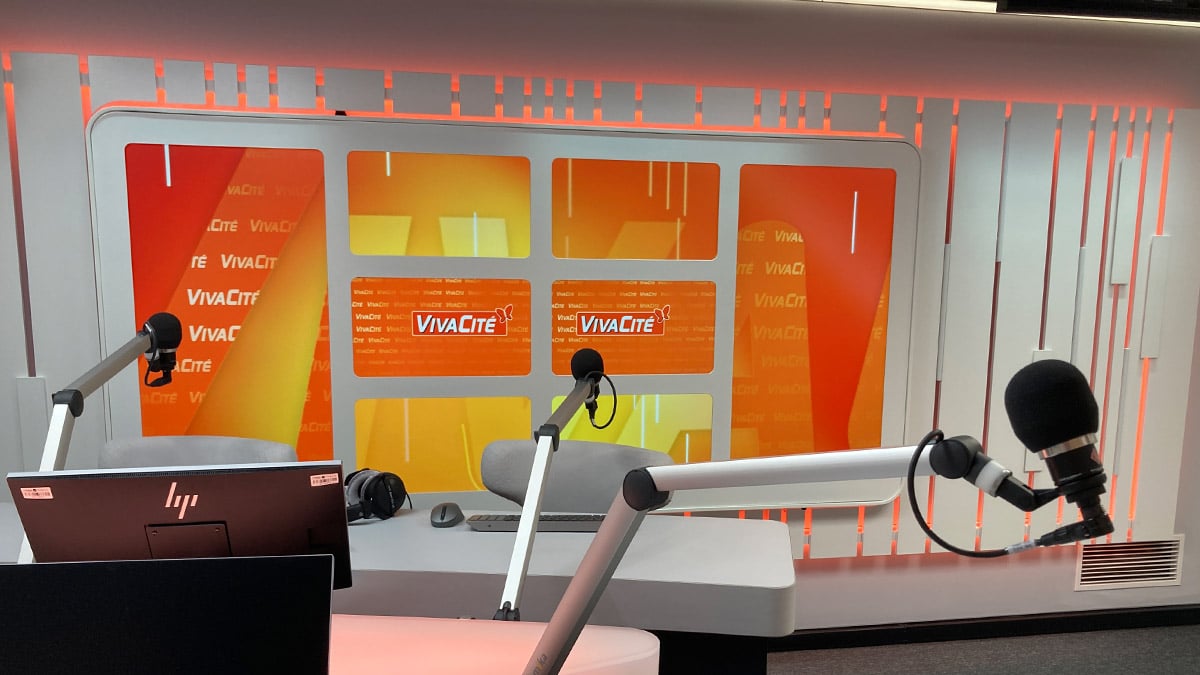NAMUR, Belgium — As part of a long-term renovation project that began two years ago with the modernization of Classic 21’s radio studios, Belgian French-language public broadcaster RTBF has recently inaugurated its new regional VivaCité studio in Namur.
RTBF started the studio renewal project renovation project for its regional studios in Libramont, Charleroi, Ottignies and finally, Mons in 2016. Just before the COVID lockdown, RTBF designed an on-air landscape for the main and production studios at Classic 21, VivaCité Mons and VivaCité’s Viva+ DAB+ channel.
“Because of the health crisis, it took us almost two years to finalize the renovation of the Namur studio,” said Etienne Tordeur, RTBF’s studio and control room coordinator and the studio renovation project leader. “The on-air room was built over a decade ago, without imaging or video facilities. It was one of RTBF’s last studios without visual radio.”
VivaCité Namur’s morning drive show, “VivaCité Matin,” hosted by Isabelle Verjans and Serge Otthiers, also runs on Namur’s regional, public-financed TV station Boukè and RTBF’s Auvio platform, so the need for new studio imaging and dynamic visual elements was key. “This was one of the major challenges throughout VivaCité’s studio upgrades,” Tordeur added. The studio must provide maximum versatility in usage, lighting, branding and imaging. “We built the studio to serve multiple purposes, and so in terms of ‘looks,’ the doors remain open for versatility.”
Tordeur emphasized that the new radio studio has no ambition to replace a TV studio. “The bottom line is that we produce high-quality radio with the possibility to distribute the video signal over our different platforms.”
Full IP-connectivity
RTBF’s engineer team handled the technical integration, installation and cabling; their creative team colleagues designed the studio’s project furniture. Amptec configured the DHD XC2 architecture and constructed the bespoke furniture and acoustic elements. “For the acoustics, we provided Artnovion Ulysses bass traps,” said Bart Lamberigts, project manager with Amptec. “The huge guest table in the center of the studio and the presenter desks were specially-designed and equipped with Yellowtec components.”
The bottom line is that we produce high-quality radio with the possibility to distribute the video signal over our different platforms.
The on-air studio was designed to operate either independently or in conjunction with the adjacent production studio and editorial office it faces. A 14-fader DHD 52/MX console is the centerpiece of the studio. “The big novelty here is that the complete audio flow is now AoIP using AES67/Ravenna technology, with the DHD console taking on the transmission of AoIP,” said Tordeur.
The Namur regional studio enjoys full IP connectivity with RTBF’s line center in Brussels. “The connection to the Reyers site is full native IP/AES67,” added Lamberigts. “This is a major leap forward compared to the codecs of the past and yields a superb, high-quality audio signal in both Namur and Brussels, with imperceptible delay.”
Strong visual aspect
The transmission of the daily morning show on TV station Boukè and streaming platform Auvio urged RTBF’s studio builders to implement dynamic and adaptable background walls and displays to make the new presenter room visually attractive. “Wired-D installed new lighting,” said Hélène Ronveaux, head of RTBF’s technology department, “and Studioline installed the new wall decoration.”
“We provide VivaCité Matin’s image flow to Boukè, but contrary to our regional VivaCité center Mediasambre in Charleroi, we don’t share the studio with the regional TV station there,” Tordeur explained, adding that the two stations in Namur don’t share technical equipment either.
The VivaCité studio has Panasonic HE40 PTZ video cameras. A Blackmagic ATEM 2 M/E video mixing system combines the feeds. “Based on our experience with our RTBF Média studios in Brussels and Mons, we developed an in-house system for the ‘shooter’ and ‘mixer’ interfaces, with video automatically following the audio signal using the DHD internal automated microphone. The integrated level detection system in the MX/52 console uses Ember+ to collect the data, which kicks off the carousel focusing on the microphone-input signal and triggers the cameras,” concluded Ronveaux.

